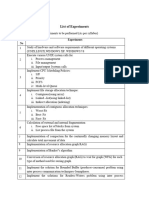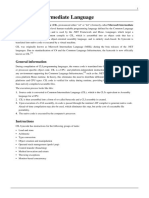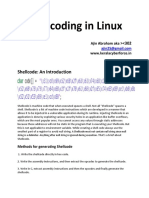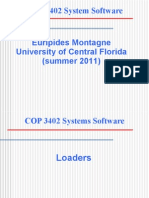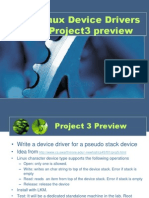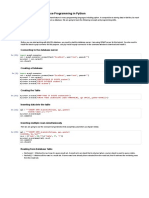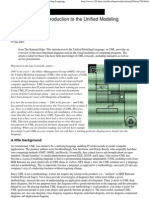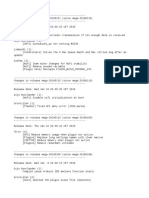0 ratings0% found this document useful (0 votes)
38 viewsBH Usa 07 Butler and Kendall
BH Usa 07 Butler and Kendall
Uploaded by
csullxThis document discusses various techniques for injecting code into other processes on Windows systems. It begins with an overview of code injection basics and user mode injection techniques using the Windows API. It then covers more advanced techniques like injecting DLLs, avoiding disk access requirements, and kernel mode injection by directly modifying process memory and thread contexts. The document aims to provide a technical understanding of how real-world malware may implement code injection capabilities.
Copyright:
© All Rights Reserved
Available Formats
Download as PDF, TXT or read online from Scribd
BH Usa 07 Butler and Kendall
BH Usa 07 Butler and Kendall
Uploaded by
csullx0 ratings0% found this document useful (0 votes)
38 views60 pagesThis document discusses various techniques for injecting code into other processes on Windows systems. It begins with an overview of code injection basics and user mode injection techniques using the Windows API. It then covers more advanced techniques like injecting DLLs, avoiding disk access requirements, and kernel mode injection by directly modifying process memory and thread contexts. The document aims to provide a technical understanding of how real-world malware may implement code injection capabilities.
Original Description:
bh
Original Title
Bh Usa 07 Butler and Kendall
Copyright
© © All Rights Reserved
Available Formats
PDF, TXT or read online from Scribd
Share this document
Did you find this document useful?
Is this content inappropriate?
This document discusses various techniques for injecting code into other processes on Windows systems. It begins with an overview of code injection basics and user mode injection techniques using the Windows API. It then covers more advanced techniques like injecting DLLs, avoiding disk access requirements, and kernel mode injection by directly modifying process memory and thread contexts. The document aims to provide a technical understanding of how real-world malware may implement code injection capabilities.
Copyright:
© All Rights Reserved
Available Formats
Download as PDF, TXT or read online from Scribd
Download as pdf or txt
0 ratings0% found this document useful (0 votes)
38 views60 pagesBH Usa 07 Butler and Kendall
BH Usa 07 Butler and Kendall
Uploaded by
csullxThis document discusses various techniques for injecting code into other processes on Windows systems. It begins with an overview of code injection basics and user mode injection techniques using the Windows API. It then covers more advanced techniques like injecting DLLs, avoiding disk access requirements, and kernel mode injection by directly modifying process memory and thread contexts. The document aims to provide a technical understanding of how real-world malware may implement code injection capabilities.
Copyright:
© All Rights Reserved
Available Formats
Download as PDF, TXT or read online from Scribd
Download as pdf or txt
You are on page 1of 60
Blackout: What Really Happened
Jamie Butler and Kris Kendall
1-2
Outline
Code Injection Basics
User Mode Injection Techniques
Example Malware Implementations
Kernel Mode Injection Techniques
Advanced Code Injection Detection via Raw
Memory Analysis
1-3
Code Injection Basics
Code Injectionrefers to techniques
used to run code in the context of an
existing process
Motivation:
Evasion: Hiding from automated or human
detection of malicious code
IR personnel hunt for malicious processes
Impersonation: Bypassing restrictions
enforced on a process level
Windows Firewall, etc
Pwdump, Sam J uicer
1-4
User Mode Injection Techniques
Techniques
Windows API
AppInit_Dll
Detours
1-5
Injecting code via the Windows API
Somewhat surprisingly, the Windows API
provides everything you need for process
injection
Functions:
Vi r t ual Al l ocEx( )
Wr i t ePr ocessMemor y( )
Cr eat eRemot eThr ead( )
Get Thr eadCont ext ( ) /
Set Thr eadCont ext ( )
Set Wi ndowsHookEx( )
1-6
1. OpenProcess
evil.exe (pid = 2222)
Kernel (via kernel32)
iexplore.exe (pid = 3333)
1
OpenProcess(3333)
2
Handle =400
hProc = 400
payload = 0xCC
3
1-7
2. VirtualAllocEx
evil.exe (pid = 2222)
hProc = 400
Kernel (via kernel32)
iexplore.exe (pid = 3333)
1
VirtualAllocEx(
hProc,
0x4000,
256,
. . .)
4
base =0x4000
base = 0x4000
2
New section
Base address =0x4000
Size =256 bytes
payload = 0xCC
5
3
1-8
3. WriteProcessMemory
evil.exe (pid = 2222)
hProc = 400
Kernel (via kernel32)
iexplore.exe (pid = 3333)
1
WriteProcessMemory(
hProc,
base,
payload,
1,
)
base = 0x4000
2
New section
Base address =0x4000
Size =256 bytes
payload = 0xCC
3
0xCC
1-9
4. CreateRemoteThread
evil.exe (pid = 2222)
hProc = 400
Kernel (via kernel32)
iexplore.exe (pid = 3333)
1
CreateRemoteThread(
hProc,
SecAttribs =NULL,
StackSize =1024,
0x4000
)
base = 0x4000
2
New section
Base address =0x4000
Size =256 bytes
payload = 0xCC
3
0xCC
4
ThreadId =11
New Thread
Id =11
Start Address =0x4000
ThreadId = 11
5
10
#I nj ect an i nf i ni t e l oop i nt o a r unni ng pr ocess
i mpor t pydbg
k32 = pydbg. ker nel 32
payl oad = \ xEB\ xFE
pi d = i nt ( ar gs[ 0] )
. . .
h = k32. OpenPr ocess( PROCESS_ALL_ACCESS, \
Fal se, pi d)
m= k32. Vi r t ual Al l ocEx( h, None, 1024, \
MEM_COMMI T, \
PAGE_EXECUTE_READWRI TE)
k32. Wr i t ePr ocessMemor y( h, m, payl oad, \
l en( payl oad) , None)
k32. Cr eat eRemot eThr ead( h, None, 1024000,
m, None, 0, None)
1-11
Better Payloads
Breakpoints and Loops are fun, but what about
real payloads?
If we directly inject code it must be position
independent
Any addresses that were pre-calculated at
compile time would be wrong in the context of a
new process
1-12
Better Payloads
Building large position independent payloads is
possible, but not trivial
However, DLL injection is much simpler
DLLs are designed to be loaded in a variety of
processes, addresses are automatically fixed
up when the DLL is loaded
1-13
DLL Injection
Use the basic process we just described
DLLs are loaded using kernel32!LoadLibrary
kernel32 is at the same address in every
process we know its address in the remote
process (ignoring ASLR)
Allocate space for the name of the DLL to be
loaded, then create a thread with a start
address that points to LoadLibrary
14
#DLL I nj ect i on Excer pt
i mpor t pydbg
k32 = pydbg. ker nel 32
pi d = i nt ( ar gs[ 0] )
dl l name = ar gs[ 1]
. . .
h = k32. OpenPr ocess( PROCESS_ALL_ACCESS, \
Fal se, pi d)
m= k32. Vi r t ual Al l ocEx( h, None, 1024, \
MEM_COMMI T, \
PAGE_EXECUTE_READWRI TE)
k32. Wr i t ePr ocessMemor y( h, m, dl l name, \
l en( dl l name) , None)
k32. Cr eat eRemot eThr ead( h, None, 1024,
k32. LoadLi br ar y, m, 0,
None)
1-15
User Mode API Variants
Rather than create a new remote thread, we
can hijack an existing thread using
Get Thr eadCont ext , Set Thr eadCont ext
Set Wi ndowsHookEx can also be used to inject
a DLL into a single remote process, or every
process running on the current Desktop
1-16
SetWindowsHookEx
SetWindowsHookEx defines a hook procedure
within a DLL that will be called in response to
specific events
Example events: WH_KEYBOARD,
WH_MOUSE, WH_CALLWNDPROC, WH_CBT
Whenever the hooked event is first fired in a
hooked thread, the specified DLL is be loaded
1-17
Permissions and Security
To open a process opened by another user
(including SYSTEM), you must hold the
SE_DEBUG privilege
Normally SE_DEBUG is only granted to
member of the Administrator group
However, even if you are running as a
normal user, malware can still inject into
another process that you own
1-18
Injecting code via AppInit_DLLs
The AppInit_DLLs registry value provides
another convenient method of DLL
injection
1-19
Injecting code via Detours
Detours is a library developed by Microsoft
Research in 1999
The library uses the same techniques
already described, wrapped up in slick
package
1-20
Detours Features
Function hooking in running processes
Import table modification
Attaching a DLL to an existing program file
Detours comes with great sample
programs:
Withdll
Injdll
Setdll
Traceapi
1-21
Setdll
Detours can add a new DLL to an existing
binary on disk. How?
Detours creates a section named
.detoursbetween the export table and
debug symbols
The .detours section contains the original
PE header, and a new IAT
Detours modifies the PE header to point at
the new IAT (reversible)
1-22
Setdll Demo
1-23
Setdll Demo
1-24
Avoiding the Disk
When we perform DLL injection,
LoadLi br ar y expects the DLL to be on
the disk (or at least an SMB share)
The Metasploit project eliminates this
requirement using a clever hooking
strategy
By hooking functions that are involved in
reading the file from disk, they fool
Windows into thinking the DLL is on disk
1-25
Meterpreter
Hook Call LoadLibrary Unhook
Hooked functions:
NtMapViewOfSection
NtQueryAttributesFile
NtOpenFile
NtCreateSection
NtOpenSection
See remote_dispatch.c and libloader.c in
MSF 3.0
1-26
Meterpreter Demo
1-27
Poison Ivy RAT
Tons of malware uses Code Injection
Well quickly dig into the details of one
example
1-28
Poison Ivy Capabilities
1-29
Step 1: Inject to Explorer
Poison Ivy client immediately injects to
Explorer and then exits
Output from WinApiOverride32 for pi.exe
1-30
Step 2: Inject again to msnmsgr.exe
Explorer.exe injected code then injects again
Interestingly, PI does not grab the SE_DEBUG
privilege, so we cant inject in many existing
processes
Output from WinApiOverride32 for explorer.exe
1-31
Did it Work?
1-32
Where is the evil?
1-33
Kernel Process Injection
1-34
Two Halves of the Process
User land processes are comprised of two
parts
Kernel Portion
EPROCESS and KPROCESS
ETHREAD and KTHREAD
Token
Handle Table
Page Tables
Etc.
1-35
Two Halves of the Process
User land Portion
Process Environment Block (PEB)
Thread Environment Block (TEB)
Windows subsystem (CSRSS.EXE)
Etc.
1-36
Kernel Process Injection Steps
Must find suitable target
Has a user land portion
Has kernel32.dll and/or ntdll.dll loaded in its address
space
Has an alterable thread (unless hijacking an existing
thread)
Allocate memory in target process
Write the equivalent of shellcodethat calls
LoadLibrary
Cause a thread in the parent to execute newly
allocated code
Hijack an existing thread
Create an APC
1-37
Allocate memory in parent process
Change virtual memory context to that of
the target
KeAttachProcess/KeStackAttachProcess
ZwAllocateVirtualMemory
(HANDLE) -1 means current process
MEM_COMMIT
PAGE_EXECUTE_READWRITE
1-38
Creating the Shellcode
shellcodethat calls LoadLibrary
Copy function parameters into address space
Pass the address of function parameters to
calls
Can use the FS register
FS contains the address of the TEB
TEB has a pointer to the PEB
PEB has a pointer to the PEB_LDR_DATA
PEB_LDR_DATA contains all the loaded DLLs
1-39
Creating the Shellcode
As an alternative to using the FS register
Find the address of ntdll.dll from the driver
Parse its exports section
Does not work with all DLLs
Only address of ntdll.dll returned by
ZwQuerySystemInformation
1-40
Thread Hijacking
Cause a thread in the parent to execute
newly allocated code - Hijack an existing
thread
Locate a thread within the parent process
Change its Context record
Change Context record back when done
Problems:
Low priority threads
Blocked threads
Changing Context back
1-41
Thread Context Hijacking
Hijack and Context records
lkd>dt nt!_CONTEXT
+0x000 ContextFlags : Uint4B
+0x004 Dr0 : Uint4B
+0x008 Dr1 : Uint4B
+0x00c Dr2 : Uint4B
+0x010 Dr3 : Uint4B
+0x014 Dr6 : Uint4B
+0x018 Dr7 : Uint4B
+0x01c FloatSave : _FLOATING_SAVE_AREA
+0x08c SegGs : Uint4B
+0x090 SegFs : Uint4B
+0x094 SegEs : Uint4B
+0x098 SegDs : Uint4B
+0x09c Edi : Uint4B
+0x0a0 Esi : Uint4B
+0x0a4 Ebx : Uint4B
+0x0a8 Edx : Uint4B
+0x0ac Ecx : Uint4B
+0x0b0 Eax : Uint4B
+0x0b4 Ebp : Uint4B
+0x0b8 Eip : Uint4B
+0x0bc SegCs : Uint4B
+0x0c0 EFlags : Uint4B
+0x0c4 Esp : Uint4B
+0x0c8 SegSs : Uint4B
+0x0cc ExtendedRegisters : [512] UChar
1-42
Alternative Method: APC
Cause a thread in the parent to execute
newly allocated code - Create an APC
Threads can be notified to run an
Asynchronous Procedure Call (APC)
APC has a pointer to code to execute
To be notified, thread should be Alertable
1-43
Alertable Threads and APCs MSDN
1-44
Finding an Alertable Thread
PETHREAD FindAlertableThread(PEPROCESS eproc)
{
PETHREAD start, walk;
if (eproc ==NULL)
return NULL;
start = *(PETHREAD *)((DWORD)eproc + THREADOFFSET);
start = (PETHREAD)((DWORD)start - THREADFLINK);
walk =start;
do
{
DbgPrint("Looking at thread 0x%x\n",walk);
if (*(PUCHAR)((DWORD)walk + ALERTOFFSET) == 0x01)
return walk;
walk =*(PETHREAD *)((DWORD)walk + THREADFLINK);
walk = (PETHREAD)((DWORD)walk - THREADFLINK);
}while (walk !=start);
return NULL;
}
1-45
Kernel Process Injection Demo
1-46
Memory Analysis
Motivation
APIs lie. The operating system can be
subverted.
Example: Unlink injected DLLs from the
PEB_LDR_DATA in the PEB.
Example: Hooking the Virtual Memory Manager
and diverting address translation.
APIs are not available to classic forensic
investigations offline analysis
1-47
Memory Analysis
Requirements
No use of APIs to gather data.
Ability to use any analysis solution on both live
memory and offline memory image dumps.
(Implies the ability to do all memory translation independently.)
Do not require PDB symbols or any other operating
specific information.
1-48
Steps to Memory Analysis
Ability to access physical memory
Derive the version of the OS important to
know how to interpret raw memory
Find all Processes and/or Threads
Enumerate File Handles, DLLs, Ports, etc.
1-49
Steps to Memory Analysis
Virtual to Physical Address Translation
Determine if the host uses PAE or non-PAE
Find the Page Directory Table process
specific
Translate prototype PTEs
Use the paging file
1-50
Derive the version of the OS
Find the System Process
Allows the derivation of:
The major operating system version in question
The System Page Directory Table Base
HandleTableListHead
Virtual address of PsInitialSystemProcess
PsActiveProcessHead
PsProcessType
Patent Pending
1-51
Operating System Version
Find the System image name
Walk backwards to identify the Process
Block
The spatial difference between major
versions of the OS is enough to begin to
tell us about the operating system version
Patent Pending
1-52
Operating System Version
Drawback: Ghosts
There can be more than one System Process
Open a memory crash dump in Windbg
Run a Windows operating system in VMWare
Solution:
Non-paged kernel addresses are global
We know the virtual address of
PsActiveProcessHead
PsActiveProcessHead and other kernel addresses
should be valid and present (translatable) in both
live or dead memory
Patent Pending
1-53
Memory Translation
PAE vs non-PAE
Different ways to interpret the address tables
The sixth bit in the CR4 CPU register
determines if PAE is enabled
Problem: We do not have access to CPU
registers in memory analysis
Solution?
Kernel Processor Control Region -> KPCRB ->
KPROCESSOR_STATE ->
KSPECIAL_REGISTERS -> CR4
1-54
Memory Translation
CR4 Heuristic
Page Directory Table Base and the Page
Directory Table Pointer Base look very
different.
CR3 is updated in the KPCR
This can be used to identify a valid Page
Directory Table
The Page Directory can be used to validate
the PsActiveProcessHead
Patent Pending
1-55
Enumerating Injected DLLs
Problem:
APIs lie.
Malware can unlink from the
PEB_LDR_DATA lists of DLLs
Solution:
Virtual Address Descriptors (VADs)
Patent Pending
1-56
VADs
Self balancing binary tree [1]
Contains:
Virtual address range
Parent
Left Child and Right Child
Flags is the memory executable
Control Area
1. Russinovich, Mark and Solomon, Dave, Microsoft Windows Internals, Microsoft Press 2005
1-57
A Memory Map to a Name
VAD contains a CONTROL_AREA
CONTROL_AREA contains a
FILE_OBJ ECT
A FILE_OBJ ECT contains a
UNICODE_STRING with the filename
We now have the DLL name
Patent Pending
1-58
Demo
1-59
Conclusion
1-60
Questions?
Email: jamie.butler AT mandiant.com
You might also like
- Lab 1Document14 pagesLab 1hackcodes.freecluster100% (1)
- From C To Assembly To Shellcode - HasherezadeDocument35 pagesFrom C To Assembly To Shellcode - HasherezadeMayan FunNo ratings yet
- Cics Question Bank 1 of 28Document28 pagesCics Question Bank 1 of 28Nicholas SchneiderNo ratings yet
- AWS Sample Resume 2Document3 pagesAWS Sample Resume 2laxmipriya ray100% (1)
- VMWorld 2014 - Advanced Topics & Future Directions in Network Virtualization With NSXDocument38 pagesVMWorld 2014 - Advanced Topics & Future Directions in Network Virtualization With NSXkinan_kazuki104No ratings yet
- AIDocument36 pagesAIShingz96100% (6)
- Anatomy of A MalwareDocument23 pagesAnatomy of A MalwareAbhineetAyanNo ratings yet
- Windows x64 ShellcodeDocument15 pagesWindows x64 ShellcodeRonaldNo ratings yet
- Advanced Exploit DevelopmentDocument57 pagesAdvanced Exploit DevelopmentPooja KhareNo ratings yet
- Adding Functions To Any Program Using A DLL: The Codebreakers-Journal, Vol. 1, No. 1 (2004)Document6 pagesAdding Functions To Any Program Using A DLL: The Codebreakers-Journal, Vol. 1, No. 1 (2004)z4rm4rNo ratings yet
- Lab11 - Code Forensics, TunnelingDocument17 pagesLab11 - Code Forensics, TunnelingLêDương AnhTuấnNo ratings yet
- On Windows Syscall Mechanism and Syscall Numbers Extraction MethodsDocument26 pagesOn Windows Syscall Mechanism and Syscall Numbers Extraction MethodsqdwqdNo ratings yet
- Mechanism of Determining Page Faults Instantaneously Via Device Driver Based Approach in LinuxDocument13 pagesMechanism of Determining Page Faults Instantaneously Via Device Driver Based Approach in LinuxmaheshmddkNo ratings yet
- Introduction To Shellcode DevelopmentDocument42 pagesIntroduction To Shellcode DevelopmentSiddas AlZerkaviNo ratings yet
- Operating System Lab FileDocument74 pagesOperating System Lab FileTusharNo ratings yet
- Customizing Public ExploitsDocument55 pagesCustomizing Public ExploitslemezlovasNo ratings yet
- Lab 2 DescriptionDocument4 pagesLab 2 DescriptionShanka UdugampolaNo ratings yet
- BCS-451 OS Lab ManualDocument92 pagesBCS-451 OS Lab ManualparasjainxyzzNo ratings yet
- Code Injection and HookingDocument23 pagesCode Injection and Hooking21st TechNo ratings yet
- Us 17 Nie Free Fall Hacking Tesla From Wireless To CAN BusDocument56 pagesUs 17 Nie Free Fall Hacking Tesla From Wireless To CAN Bus陈彦志No ratings yet
- ShellcodeDocument8 pagesShellcodeTrang Lò ThịNo ratings yet
- Malware-DynamicAnalysis-1Document31 pagesMalware-DynamicAnalysis-1Ruben Lopez BarrioNo ratings yet
- CS609 CURRENT MIDTERM SOLVED SUBJECTIVE by JUNAIDDocument11 pagesCS609 CURRENT MIDTERM SOLVED SUBJECTIVE by JUNAIDTuba AkmalNo ratings yet
- CS609 CURRENT MIDTERM SOLVED SUBJECTIVE by JUNAID-1Document9 pagesCS609 CURRENT MIDTERM SOLVED SUBJECTIVE by JUNAID-1Hamza KhanNo ratings yet
- How To Write Malware and Learn How To Fight It!Document40 pagesHow To Write Malware and Learn How To Fight It!Wesley HaripoNo ratings yet
- Synthesis Tutorial V 1.3Document20 pagesSynthesis Tutorial V 1.3Venkat PatchigollaNo ratings yet
- 0xC Python Tutorial - Python MalwareDocument8 pages0xC Python Tutorial - Python MalwareMihai Qra100% (1)
- Topics 82 92Document9 pagesTopics 82 92sazadinazaNo ratings yet
- Common Intermediate LanguageDocument7 pagesCommon Intermediate LanguageLyle BickleyNo ratings yet
- Code Injection and HookingDocument54 pagesCode Injection and HookingShivam PandeyNo ratings yet
- Free ArtDocument8 pagesFree ArtCarlos PerezNo ratings yet
- CS 8581-Lab-ManualDocument39 pagesCS 8581-Lab-ManualAarkaNo ratings yet
- Shellcoding in LinuxDocument15 pagesShellcoding in Linuxkartikey jainNo ratings yet
- Chapter 4Document20 pagesChapter 4duyhuy362003No ratings yet
- Rootkits Part2Document69 pagesRootkits Part2Alexander MejiaNo ratings yet
- The Art of Unpacking - Part 1Document73 pagesThe Art of Unpacking - Part 1elabir100% (2)
- Direct Kernel Object ManipulationDocument45 pagesDirect Kernel Object ManipulationCameron DeanNo ratings yet
- Offensive VBADocument50 pagesOffensive VBATường HuỳnhNo ratings yet
- Hacking WinceDocument30 pagesHacking WinceJohn NihaNo ratings yet
- Shellcoding For Linux and Windows TutorialDocument12 pagesShellcoding For Linux and Windows TutorialcaedumelloNo ratings yet
- Hacking Windows CeDocument29 pagesHacking Windows Cemaq213No ratings yet
- 08 09 Exploit Development 102Document137 pages08 09 Exploit Development 102SonyaNo ratings yet
- Unearthing Vulnerabilities in The Apple Ecosystem The Art of KidFuzzerV2.0 Offensivecon 2023Document75 pagesUnearthing Vulnerabilities in The Apple Ecosystem The Art of KidFuzzerV2.0 Offensivecon 2023ZhenPeng PanNo ratings yet
- Reversing Encrypted Callbacks and COM InterfacesDocument31 pagesReversing Encrypted Callbacks and COM InterfacesTravis SolomonNo ratings yet
- Mrxsmb-Ring0-Advisory (REVERSING MRXSMB - SYS)Document10 pagesMrxsmb-Ring0-Advisory (REVERSING MRXSMB - SYS)Константин К.No ratings yet
- Introduction To VLSI Design LabDocument4 pagesIntroduction To VLSI Design LabPraveenNo ratings yet
- Abuse SVCHost MethodsDocument35 pagesAbuse SVCHost MethodsAsad AhmedNo ratings yet
- Linux PresentationDocument77 pagesLinux PresentationssanagavNo ratings yet
- COP3402 Lecture11Document31 pagesCOP3402 Lecture11abhirbhandaryNo ratings yet
- CS2257Document43 pagesCS2257ramauma100% (1)
- Malware FileDocument17 pagesMalware Filevaibhavsharmaee22b1860No ratings yet
- DLL InjectionDocument16 pagesDLL InjectionNierNo ratings yet
- Xu Hao Xiabo Chen Find Your Own IOS Kernel BugDocument74 pagesXu Hao Xiabo Chen Find Your Own IOS Kernel Bugtonygh2023No ratings yet
- Intro To Windows Kernel Security Development (uCON-Conference 2009)Document75 pagesIntro To Windows Kernel Security Development (uCON-Conference 2009)Wonhui LeeNo ratings yet
- Core Dump AnalysisDocument31 pagesCore Dump AnalysisRahul BiliyeNo ratings yet
- 06 Software Security 3Document41 pages06 Software Security 3SouhilaNo ratings yet
- Us 18 Stone Unpacking The Packed UnpackerDocument45 pagesUs 18 Stone Unpacking The Packed UnpackerShashankNo ratings yet
- 751abbdfOS CO204 Sample Lab File 2023 (For Prof. Anil Singh Parihar)Document37 pages751abbdfOS CO204 Sample Lab File 2023 (For Prof. Anil Singh Parihar)Nikhil SharmaNo ratings yet
- Operating System ProcessDocument57 pagesOperating System Processsasongko wardhanaNo ratings yet
- 05 Systemc TutorialDocument32 pages05 Systemc TutorialjasonturfNo ratings yet
- Assembly 05Document41 pagesAssembly 05minanessim100No ratings yet
- LinuxddDocument26 pagesLinuxddroc_rocNo ratings yet
- Chat Program Two Way Communication Java: S. Nageswara Rao, Corporate Trainer June 8, 2011 36 CommentsDocument29 pagesChat Program Two Way Communication Java: S. Nageswara Rao, Corporate Trainer June 8, 2011 36 CommentsannNo ratings yet
- MD S2Document143 pagesMD S2Mohanned AliNo ratings yet
- Mini Project Report SampleDocument25 pagesMini Project Report SampleSakshi IssarNo ratings yet
- Compat IniDocument6 pagesCompat Inihisohiso100% (1)
- Creating Ix1 Id PicturesDocument15 pagesCreating Ix1 Id PicturesFernando Lipardo Jr.No ratings yet
- Credit Card Management System: AbstractDocument3 pagesCredit Card Management System: AbstractSeethal KumarsNo ratings yet
- M. Tech Synopsis FormatDocument12 pagesM. Tech Synopsis FormatOorvi ThakurNo ratings yet
- Types of Programming LanguagesDocument6 pagesTypes of Programming LanguagesDhanashriPitreNo ratings yet
- SQL Python ConnectDocument2 pagesSQL Python ConnectHariOm DwivediNo ratings yet
- Java SyllabusDocument10 pagesJava Syllabusankit boxerNo ratings yet
- UML Basics - An Introduction To The Unified Modeling LanguageDocument8 pagesUML Basics - An Introduction To The Unified Modeling LanguagetokmakcanNo ratings yet
- Inf3AB5 - NotepadDocument253 pagesInf3AB5 - Notepadkareyo47No ratings yet
- Decision TreeDocument18 pagesDecision TreeMo ShahNo ratings yet
- Emebbedd Question BankDocument25 pagesEmebbedd Question Banksujith100% (3)
- Release NotesDocument83 pagesRelease Notespascaru_alinNo ratings yet
- Changes in Bash Version 4.2 To Bash 4.3Document123 pagesChanges in Bash Version 4.2 To Bash 4.3LordAjaxNo ratings yet
- Project Report For Advanced Encryption System CompltedDocument88 pagesProject Report For Advanced Encryption System CompltedRotimi Dammy David RotboticsNo ratings yet
- Fibonacci in 68000 Assembler 68000 Assembler Directives: Example For Definition of Memory SegmentsDocument2 pagesFibonacci in 68000 Assembler 68000 Assembler Directives: Example For Definition of Memory Segmentsray2112No ratings yet
- Acpi Config Power Interface SpecDocument624 pagesAcpi Config Power Interface SpecdraNo ratings yet
- LTSP Detail TutorialDocument10 pagesLTSP Detail TutorialansaarNo ratings yet
- Logix 5000 Instruction Execution TimeDocument166 pagesLogix 5000 Instruction Execution TimeMike AbacusNo ratings yet
- Ch6. Transport LayerDocument113 pagesCh6. Transport LayerAbdulaziz MohammedNo ratings yet
- Computer Graphics: Presented By: Yogesh Nagaraj NaikDocument26 pagesComputer Graphics: Presented By: Yogesh Nagaraj Naikಯೋಗೇಶ್ ಪಿNo ratings yet
- MySql PresentationDocument33 pagesMySql PresentationMansoob Baig100% (1)
- Class 12 Cs Ncert Cbse 2014-15 PythonDocument328 pagesClass 12 Cs Ncert Cbse 2014-15 PythonQuarnox Xenott100% (1)
- Eqommand: User ManualDocument53 pagesEqommand: User ManualPieter-Paulus VertongenNo ratings yet


















